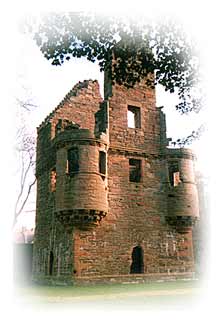
 |
 |
| Home |
| About Orkney |
| History |
| Tradition |
| Folklore |
| Placenames |
| Images |
| Downloads |
| About the Site |
| Contact |
| Links |
| Search Site |
| Awards |
| Earl Patrick Stewart - 'Black Patie' | |

In 1593, the “iron grip” of the Stewart earls passed from Earl Robert to his second son, 28-year-old Patrick Stewart. Like his father before him, Patrick’s rule over Orkney was not a particularly pleasant one, earning him the nickname "Black Patie". Patrick's reputation for extravagance, arrogance and greed was matched only by his love of finery - exemplified in the magnificent Earl's Palace in Kirkwall. "[Earl Patrick Stewart's] pomp was so great, as he never went from his castle to the kirk, nor abroad otherwise, without the convoy of fifty musketeers, and other gentlemen of convoy and guard. And sichlike before dinner and supper, there were three trumpeters that sounded still till the meat of the first service was set at table, and sichlike the second service, and consequently, after the grace. He also had his ships directed to sea to intercept pirates and collect tribute of foreign fishers that came yearly to these seas. Whereby he made sic collection of great guns and other weapons of war, as no house, palace, nor castle, yea in all of Scotland were not furnished with the like." Patrick Stewart held the native Orcadians in very low regard. When not bickering with his own family, his time was spent feuding with the more powerful local families. By 1606, Earl Patrick was heavily in debt and ignored a summons to appear before the Privy Council, in Edinburgh, to explain the complaints received regarding his extremely oppressive rule. He was even charged with treason but the charge was dropped in 1607. The appointment of Bishop James Law, in the same year, marked the beginning of Patrick's end. The bishop, a close friend and confidante of the Scottish king, James VI (and I of England), presented a petition before the king, describing the oppression suffered by the people of Orkney. It is thought he also made mention of the danger the Stewart family posed - at this time the islands were still more Norse than Scottish. The latter statement probably prompted the King to take action. In 1610, at the age of 35, Earl Patrick Stewart was indicted on seven charges of treason, on the ground of usurping royal authority. He remained in Edinburgh Castle, despite pleading justification for his actions on the islands' County Laws. While incarcerated, Patrick appointed his illegitimate son, Robert, as his deputy in Orkney. Robert had instructions to regain his father's "houses" and to collect rents to prepare for his hoped-for restoration to the Earldom. Robert's attempt to comply with his fathers orders resulted in what amount to a rebellion against royal authority. Earl George Sinclair of Caithness - who had a score to settle with the Stewarts - came to the King's aid, volunteering to lead and pay for an expedition to Orkney to quash Robert Stewart's rebellion. After a long siege of the Kirkwall Castle, the Bishop's Palace and St Magnus Cathedral - where supporters were garrisoned - the Stewart rebellion was brought to its knees by the work of a traitor working from the inside. Robert Stewart was convicted of treason and hung in January 1615. Earl George threatened to demolish St Magnus' Cathedral as a reprisal against the Orcadians who had nearly ruined him but fortunately Bishop Law persuaded him otherwise. Patrick Stewart, the man destined to become Orkney's most despised earl, was found guilty of treason in 1615, and subsequently beheaded. And according to tradition, so wicked was he that his execution had to be delayed for several days to give him time to learn the Lord's Prayer. |
Born 1565
Died 1615 It was Earl Patrick that initiated Orkney's first recorded prosecution for witchcraft. In 1594, less than a year after coming to power, Alison Balfour was burned at Gallow Hill in Kirkwall. Unofficially, the accusation of witchcraft had become a particularly convenient way of depriving people of their land - in the following century there were many trials, often beginning in St Magnus Cathedral and ending at the stake. |